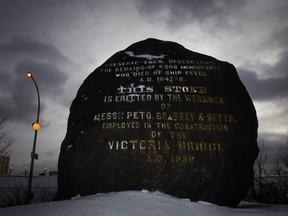The Irish community has long sought a bigger and more accessible site. Hydro-Québec’s land transfer opens the way. But much remains to be done.

Amid the railing and intolerance of current debates on immigration and integration, an event can sometimes occur that reminds us that kindness to strangers in need has been the historical norm.
Montreal is the site of a mass grave that contains the remains of some 6,000 Irish immigrants who died here after fleeing the horrors of the “Great Hunger.”
Thanks to an extraordinary effort by Montreal’s Irish community, working together with Hydro-Québec and the City of Montreal, that site is to become the home of a fitting memorial. The massive and emblematic Black Rock, placed there by workers in the 1850s to protect the site from desecration, will now have much easier access for the public so that the history of the place will be available to, and understood by, future generations.
In the summer of 1847, some 75,000 victims of the mass starvation that ravaged Ireland arrived in Montreal.
The scope of that influx can only be comprehended when compared to the size of Montreal’s population, which was only 50,000 at the time.
Yet, whether here or in Quebec City, the local populace showed compassion in doing everything they could to help the poor souls who were suffering from the typhus that was rampant on the ships that brought them to these shores.
Montreal’s mayor at the time, John Easton Mills, was one of those who volunteered to help in the “fever sheds” where the sick had been quarantined. He caught typhus and died in November 1847.
One of the most moving examples of empathy came from the Mohawk community near Montreal. They had been victims of colonization and racism for generations and lived in deep poverty. History reminds us that despite their own situation, they saw the pitiful state of these new arrivals and showed deep compassion in bringing whatever comfort and food they could to help alleviate their suffering.
At last week’s announcement of the agreement with Hydro-Québec, volunteers from the Irish community of Montreal — like Fergus Keyes and Scott Phelan — who had worked for years to secure the deal were joined by Kahnawake’s Grand Chief Cody Diabo, a fitting recognition of the importance of the Mohawk’s selfless contributions during that time of great need.
The new ambassador of Ireland to Canada, John Concannon, spoke movingly (including in his excellent French) about the history of the connection between Quebec and Ireland. Underscoring its importance, Concannon made it his first official event since becoming ambassador.
In the Saint-Lawrence River, near Quebec City, at Grosse Îsle, the Irish Memorial National Historic Site is run by Parks Canada. It contains the Irish cemetery and a massive Celtic Cross. The quarantine sheds and other buildings are there as important reminders of the horrific events of the 1800s.
No such memorial exists in Montreal.
That’s why last week’s announcement by Hydro-Québec that it was handing over acres of land to the Irish community to build a fitting memorial is so important.
What followed can only be described as a model of corporate social responsibility. Hydro understood the importance of the site and for years did the hard work of reaching out and building consensus. It deserves to be recognized.
A lot remains to be done. There will have to be continued fundraising to build the memorial, but nothing would have been possible without the grant of the land.
That memorial can be an enduring reminder that openness toward others has been a fundamental value in building our home together.
Tom Mulcair, a former leader of the federal NDP, served as minister of the environment in the Quebec Liberal government of Jean Charest.